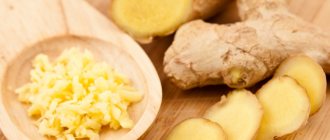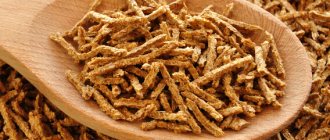What is ginger
Ginger, or Zingiber officinale, belongs to the same family of spices as turmeric and cardamom, the Zingiberaceae. India, China and the vast expanses of Southeast Asia are considered its homeland. But it is known that in ancient times this plant was also revered for its excellent taste and medicinal properties in Ancient Greece and Ancient Rome, where it came from China. In the 16th century, Europe also learned about ginger, where the plant was brought from the East Indies.
Ginger is a trailing perennial with thick, tuberous underground stems (rhizomes). Its botanical name comes from the Sanskrit word zingiber, which means “horn-shaped”, which matches the appearance of ginger [1]. It is a plant with narrow ribbed green leaves and white or yellowish-green flowers that can reach a meter in height.
Today it is cultivated mainly in tropical countries. The main suppliers of goods are Jamaica, India, Fiji, Indonesia, Australia. It is believed that the Jamaican variety of the plant (paler) is more suitable for culinary needs.
How to choose ginger
There are absolutely no difficulties here. After all, this is not frozen fish, the appearance of which is not visible under a layer of polyethylene, and not pineapple, which, although beautiful on the outside, can turn out to be absolutely tasteless. Look at the root: if its surface is smooth, even, slightly golden, the root is not flaccid and without visible damage - you can buy such ginger.
Knowing how to choose potatoes, you can easily distinguish the “wrong” ginger from the “correct” one: the old root is covered with threads, thickenings, and may have potato-like eyes on it. It's not worth choosing. It has already lost its beneficial properties and taste.
Nutrients
Ginger is not a good source of calories, protein or fiber, but it can provide many other beneficial components to the body.
This root contains significant amounts of amino acids and antioxidant compounds, such as gingerol (which gives it its fiery taste), beta-carotene, capsaicin, curcumin, caffeic and salicylic acids. Nutritional value per 100 g of fresh product [2]
| Calorie content | 80 kcal |
| Carbohydrates | 15.77 g |
| Squirrels | 1.82 g |
| Fats | 0.75 g |
| Cellulose | 2 g |
| Sodium | 13 mg |
| Calcium | 16 mg |
| Iron | 0.6 mg |
| Potassium | 415 mg |
| Magnesium | 43 mg |
| Phosphorus | 34 mg |
| Zinc | 0.34 mg |
| Vitamin B6 | 0.15 mg |
| Vitamin C | 5 mg |
| Folic acid | 11 mcg |
| Riboflavin | 34 mcg |
| A nicotinic acid | 0.75 mg |
Beneficial features
Ginger can rightfully be called a miracle of nature. This product, even in small quantities, helps to overcome various ailments, get rid of free radicals, and also restore muscles after intense exercise.
Has a beneficial effect on digestion
The phenolic compounds contained in ginger help reduce irritation of the gastrointestinal tract (GIT), stimulate the production of saliva and bile, and reduce stomach cramps.
Relieves attacks of nausea
Ginger, raw or in the form of tea, can relieve nausea of various origins (toxicosis in pregnant women, motion sickness, nausea during chemotherapy).
Acts as a pain reliever
A study conducted by researchers at the University of Georgia involving 74 volunteers found that daily consumption of ginger reduced muscle pain by 25% [3]. In addition, 83% of women who participated in other experiments confirmed the ability of ginger extract to reduce menstrual pain [4]. And a piece of this root is enough to soothe a sore tooth.
Eliminates inflammation
In many countries, ginger is used as an anti-inflammatory agent. Laboratory studies have confirmed the ability of this plant to relieve inflammatory processes, in particular in the digestive system. Moreover, ginger has been shown to be effective in treating symptoms associated with osteoarthritis [5]. This ability is given to the root by gingerol, a unique substance included in the product.
Prevents cancer
The active component of ginger, gingerol, is also known as an anti-cancer agent. Studies have shown that this substance can inhibit the growth of colorectal cancer cells [6]. In addition, ginger preparations have been proven effective in stopping the malignant degeneration of ovarian cells.
Strengthens immunity
Vitamin C and other active components that make up ginger root have a general strengthening effect on the human body. But when consuming, for example, ginger tea as a preventive measure during cold seasons, it is important to maintain the correct dosage. Horned root is not a product that should be consumed in large portions. Two small slices are enough to brew a cup of healthy tea.
Fights excess weight
They say that the ginger diet was developed by ancient Chinese healers. Today it is difficult to say whether this is true or a myth. But many claim that tea made from this healing root makes it easier to lose weight.
Those who have tried the ginger diet say that this exotic tea reduces appetite and speeds up metabolic processes in the body [7]. The most popular recipe for ginger weight loss is to drink a glass of tea with lemon half an hour before a meal. However, this method of weight loss is contraindicated for people with gastritis, ulcers, bleeding and allergies to citrus fruits.
Treats sore throat
Possessing pronounced analgesic, antiseptic, anti-inflammatory and antipyretic properties, ginger root serves as an effective cure for sore throat, laryngitis and pharyngitis.
To treat these diseases, ginger essential oil or powdered root is suitable. Add in small quantities to inhalations, compresses, and rinses. Also useful in the form of tea.
Normalizes the functioning of the genital area
Horned root promotes the proper functioning of the reproductive system in men and women. Dishes seasoned with spices protect men from impotence, prevent prostatitis, and improve erection. The benefits for the female body include the regulation of hormonal levels, as well as the normalization of the functioning of the reproductive organs.
Natural freshener
Don't know how to get rid of the smell of garlic? This bad breath, like any other, will be eliminated by ginger. Just chew a small piece of the root to freshen your breath. And what is important, this plant does not mask unpleasant odors, but completely removes them, killing bacteria in the oral cavity.
Other useful properties:
- prevents strokes, heart attacks;
- reduces glucose levels in patients with type 2 diabetes;
- reduces the concentration of cholesterol in the bloodstream;
- regulates the process of blood clotting.
- THE CORRECT APPROACH TO GINGER
- WE BUY THE HEALTHIEST FRESH GINGER
- WE BROUGHT GINGER HOME. WHAT'S NEXT?
- STORING GINGER
- HOW TO GROW GINGER AT HOME
- TECHNOLOGY FOR GROWING GINGER STEP BY STEP
WE BUY, STORE, GROW GINGER
THE CORRECT APPROACH TO GINGER
You can buy a miracle root in large stores. But even the most elite supermarket is, alas, not a guarantee of quality. But the taste and, most importantly, medicinal properties depend on what root you buy, how you prepare and store it.
Ginger is sold in pieces of rhizomes, ground, candied or dipped in chocolate, and also as an extract for ginger beer. Ground dry ginger cannot replace fresh ginger because it has a completely different aroma and taste. Dried ginger (sont) is more pungent than fresh ginger, so it is recommended to soak it before using it.
The bottom teaspoon of dried ginger is equal to one tablespoon of grated fresh ginger.
WE BUY THE HEALTHIEST FRESH GINGER
White and black ginger are available for sale.
Black is obtained by thoroughly washing the root in water with a brush.
White ginger is additionally treated with a 2% solution of bleach or sulfurous acid for 6 hours after removing the skin from the root. Sometimes cleaned roots are rubbed with chalk after washing and drying.
Black ginger (Barbados) has a stronger odor and pungent taste compared to white (Bengal), since some of the aromatic substances evaporate during processing. In our stores, white ginger is found much more often, this is justified by the fact that in European cuisine it is not customary to prepare such spicy dishes as in Eastern cuisine. Therefore, white ginger is closer to us in terms of taste.
Try to buy ginger that is fresh, smooth, not wrinkled, firm to the touch, and low in fiber. Veins and fibers indicate that this is an old root. As a rule, young roots are collected 5–6 months after planting. Ginger left to ripen in the ground for about a year becomes fibrous and acquires a strong pungency. It is only suitable for grinding into powder.
Remember that the longer the root, the richer it is in essential oils and microelements. A fresh, spicy smell is an indicator of high quality ginger. You can discreetly pick at the skin with your fingernail - if it comes off easily and a rich aroma immediately appears, feel free to buy it!
WE BROUGHT GINGER HOME. WHAT'S NEXT?
We chop, grate, cut or chop fresh ginger, depending on the recipe. But before that, you need to peel it by scraping it off with a sharp knife. The main beneficial substances of ginger are located under the skin, so when peeling it should be cut very thin. Please note that young ginger has such a delicate skin that it can be scraped, rather than cut, like new potatoes.
To grate the ginger, use a fine metal grater. It is not recommended to use wooden utensils for cleaning and chopping ginger - it will absorb the pungent odor and retain it for a long time. It will be better if you dedicate a special board and grater just for ginger (and possibly other spices).
You can squeeze the grated ginger.
Then you will get ginger juice, which is used in its pure form as a dressing for salads and sweet dishes. HOW TO CUT GINGER
Unfortunately, if a recipe calls for chunks of ginger, you'll have to do it by hand. You won't be able to get cubes of the right size in a food processor because the tough fibers that run through ripe ginger won't cut when grinding, and instead of neat pieces you'll end up with a mush with long fibers.
Cutting ginger is not difficult if you have some skill.
1. Peel the ginger before use.
2. Using a standard kitchen knife, try to cut the ginger into uniform thickness and thin slices as much as possible. The thinner the slices, the smaller the cubes will be.
3. Stack the slices on top of each other like a deck of cards.
4. Cut into thin strips and then into cubes. Ideally, you should end up with cubes of the correct shape. If you still don’t have enough skill, you can continue grinding chaotically until you get the desired size. Now you can start cooking.
STORING GINGER
Fresh ginger can be stored in the refrigerator for about a week. The dried root retains its properties for up to 4 months. Dried, unpeeled ginger roots should be stored in a cool, dark place. Some people store ginger frozen for up to several months, but it’s worth saying right away that this greatly affects its taste and, most importantly, healing qualities. The best composition of vitamins and amino acids is, of course, in the fresh root.
Here and there you can find advice of this kind: “I buy ginger, peel it, wrap it in plastic wrap and put it in the freezer. You can use it for at least six months.” You can immediately say that this is a ruined product and wasted money. When frozen, only the pungency will be preserved, but valuable amino acids and especially vitamins will be irretrievably lost along with the subtle lemon-spicy aroma. There is no point in using such ginger for medical purposes. You can probably add it to some dish - there will be no harm. But whether you will get true pleasure from such a dish is a big question. It is better not to experiment, but to follow a simple rule: plants and fruits grown in a lot of heat should not be frozen at all.
But, if you still had to store the ginger in the refrigerator (for example, you didn’t use the whole root at once), do not put it in plastic bags. It is better to put the root in a hermetically sealed container or in any enamel or glass container with a lid.
Another secret: in order to preserve the aroma and taste of fresh ginger for a long time for culinary purposes, you need to peel it and add vodka or sherry.
HOW TO GROW GINGER AT HOME
You already understand that the most valuable ginger is fresh ginger with a thin skin. It's not easy to buy one in a store. But don't be upset. It turns out that ginger can be grown at home in a pot and then you will always have this useful spice at your fingertips in its best form.
So, if you have at least a slight inclination towards gardening and some free space on the windowsill, you are quite capable of growing your own ginger root.
By the way, ginger is a rather beautiful plant with a height of half a meter to a meter. In many European homes it can easily be found on the windowsill as an indoor flower. Moreover, all parts of the plant emit a pleasant, delicate lemon aroma and are said to repel insects.
TECHNOLOGY FOR GROWING GINGER STEP BY STEP
You need to purchase the freshest, smoothest and most shiny rhizome from the store or from the “eastern” market.
We can say that this is the most difficult part of the process. Further everything is well known and understandable. PREPARATION OF PLANTING MATERIAL
If you have planted potatoes yourself at least once in your life (or at least seen others doing it), then you know the technology. If not, we proceed as follows: separate a piece of ginger rhizome with one or two live buds (they really look like potato ones). If the rhizome has dried out a little, you can keep it in warm water for several hours to awaken the dormant buds. Just don't take hot tap water. It is better to pour regular cold tap water (or filtered) and slightly heat it on the stove.
In this way, the rhizome is cut into pieces 2.5–5 cm long (with a mass of 20–25 g) with one or two well-developed buds.
PLANTING
Plant horizontally with the buds up in a wide, low container with a diameter of 20 cm, filled with a soil mixture consisting of equal parts of garden loam, sand and compost.
If you plan to eat your ginger, it is best to use organic mixtures designed for growing vegetables. The ginger rhizome should not be planted very deeply. Good drainage (for example, using expanded clay) is an absolutely necessary condition for growing ginger. When water stagnates, the rhizomes of the plants rot. Therefore, we lay drainage at the bottom of the pot, then fill it three-quarters with soil mixture, place a piece of root on it horizontally and sprinkle it with soil on top to the top of the pot. CARE AND WATERING
The last step is to take care of it. Watering should be done carefully so that the soil in the pot is evenly moist, but in no case wet. Therefore, it will be better if you alternate watering: one day - top, the other day - bottom, in a pan. This watering rule should be followed throughout the life of the plant. Remember also that the amount of watering depends on the air temperature: at low temperatures, watering should be moderate, at hot temperatures – intense.
Place the pot with the planted ginger in a well-lit place, but protected from direct sunlight. When the seedlings appear, feed the plant with organic fertilizers for tropical plants, which are sold in flower shops. Fertilizer watering is best done in the evening. Only healthy plants can be fertilized during the period of growth and flowering. You cannot fertilize unrooted or diseased plants. Fast growing plants are fertilized more often, slow growing plants less often. Do not apply fertilizer when the earthen ball is dry. You need to first moisten it well and then apply fertilizing water.
For most indoor flowering plants, it is recommended to apply complete mineral fertilizer at least twice - during budding or the formation of flower buds.
Keep the plant in a warm and bright room.
For the summer, you can place a pot of ginger on a glassed-in balcony (if you are in a city apartment) or in a greenhouse (if you are in a country house or dacha). It is important to keep the plant away from direct sunlight and wind, while providing it with rarefied light, hot temperatures and high humidity. Since the crop comes from the humid tropics, you will have to carefully water it all year round, spray it with warm water, keep it warm and protect it from direct sunlight. In winter, the windowsill is not the best place for a pot of ginger, because there are often drafts that can damage the plant. HARVESTING
After a few weeks, you will have a tall, slender herbaceous plant that resembles bamboo. Its graceful stems will bear glossy, dark green leaves that will turn yellow over time. In a few months, new stems will grow from the rhizomes, on which, if you are lucky, white spike-shaped inflorescences may appear. Those who have seen the rare flowering of ginger say that it is quite beautiful. The plant produces a flower on a long basal stem. The ginger flower is light yellow in color with a purple edge, surrounded by bracts.
In autumn, ginger plants enter a dormant period. This is the right time to remove the plants from the pot and harvest the fruit in the form of multiplied underground shoots. In Southeast Asia, the homeland of ginger, the harvest is harvested in early March. This is the end of the cold season, although the cold at this time is relative - about 27 degrees in the shade. You need to navigate by the shoots: you will notice that there are a lot of them: from six to eight, which means you can get tender and nutritious roots.
But don't use all the ginger. Save one of the “bumps” with a bud for a new planting. If you need a little ginger root before the whole plant is ready, carefully open part of the rhizome and cut off a piece of the shoot. Then cover the slightly open part with soil and the plant will continue to grow.
Table of contents
Precautionary measures
For centuries, “horned root” has been used as a general tonic. However, you should still take this plant for medicinal or preventive purposes with extreme caution, since side effects may occur in combination with some herbs or medications. In case of overdose, diarrhea, heartburn, and belching are possible.
It is important for people with gallstones to consult a doctor before consuming ginger. In addition, this product is contraindicated in cases of bleeding. Individuals taking blood thinners are advised to avoid this product as it may increase the risk of bleeding [10]. While taking glucose-lowering drugs, it can cause hypoglycemia in diabetics, and together with medications for hypertension, a sharp decrease in blood pressure and arrhythmia. In addition, ginger can aggravate reflux symptoms.
Benefits of Ginger Tea
Ginger tea not only warms you up in cold weather, but also enriches the body with many beneficial substances. The rich vitamin composition of this drink makes it extremely useful for people with influenza or ARVI. This drink is also said to be very good for weight loss.
To prepare this healing remedy, you will need 20–40 g of fresh ginger (cut into slices) and a glass of boiling water. Pour water over the roots and let it brew. Add a little honey and a slice of lemon. That's it, the miracle drink is ready!
By the way, tea is not the only drink that can be prepared from this plant. In the 19th century, bartenders in English pubs added ground ginger to their ale. It is believed that the British borrowed this recipe from the ancient Greeks, who even added ginger powder to bread.
Methods for preserving ginger
In white wine
Thinly chopped root (pre-peeled) can be poured with white wine and refrigerated. This way it will keep for several weeks. Very good to use for sauces and other dishes.
In vodka
You can preserve ginger in alcohol by placing a whole piece or root plates in vodka or alcohol and letting it brew for 2-3 weeks. The root itself is used as usual, and the tincture is well suited for adding to tea, fruit drinks, syrups in order to increase the beneficial properties and taste.
In sugar
If you are planning on making ginger ale (can you?











